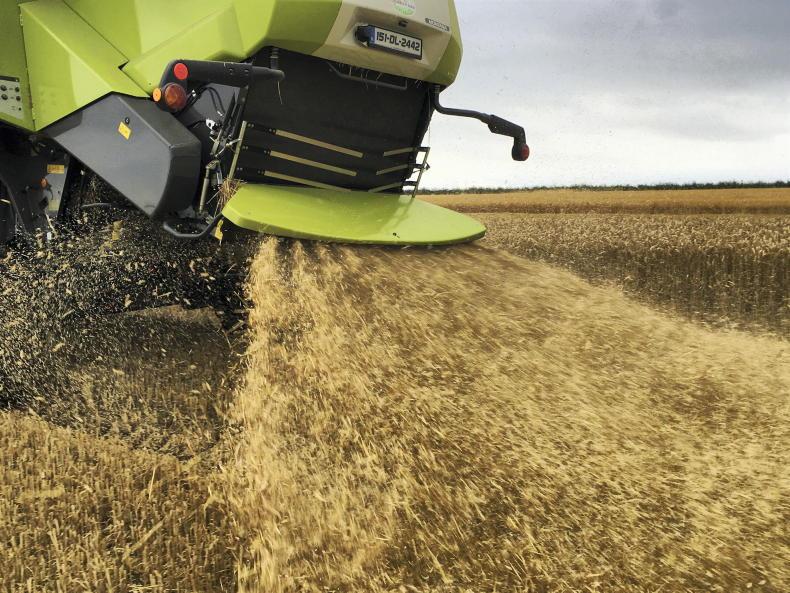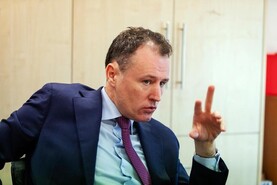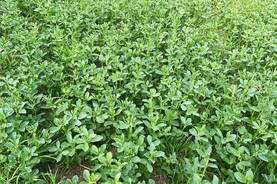The average payment per farmer under the €10m straw incorporation measure (SIM) will be €4,546, a Department of Agriculture official has told the Irish Tillage and Land Use Society's (ITLUS) summer webinar.
The uptake of the measure has been positive. Last week, the Irish Farmers Journal reported that almost €9m of the €10m budget is currently accounted for.
On Thursday, senior inspector at the Department of Agriculture Michael Moloney gave the latest update on the measure, giving a quick rundown of how the applications look at the minute, as well as what will happen next.
The Department official noted that he would like to see the measure run again next season, but was not giving any definitive answers before the scheme is reviewed. There is still a lot to be done on this season's applications.
Straw scheme stats
1,957 applicants.38,668ha.€8,897,360 (total spend).Average payment €4,546/application.Crop breakdown
Oats - 33% (45% of total oat area).Barley - 25% (5% of total barley area).Wheat - 22% (14% of total wheat area).Oilseed rape - 20% (69% of total oilseed rape area).There was also a small area of rye; approximately 80ha.The largest number of applications came from counties Wexford, Cork, Meath and Kildare.What next?
Amendments to the SIM are accepted until 12 June without a penalty via the Basic Payment Scheme (BPS) system.
After this date, amendments will be examined on a case-by-case basis.
Applicants cannot withdraw if notified of a problem or an on-farm inspection.
Possible issues after 12 June
Moloney noted that he hopes those currently in the scheme will stay in the scheme, but they can withdraw before 12 June or where there is a genuine reason not to chop that straw they can withdraw after this date.
For example, if there was an animal welfare issue due to a straw shortage.
Examples of changes
If an applicant wants to switch a parcel they can, but they cannot increase the area. For example, if a crop was lodged you could switch with another crop.If an applicant wants to reduce the area or withdraw, an explanation is needed.Applicants cannot withdraw if notified of a problem or of an on-farm inspection.Moloney also reminded applicants that full parcels must be chopped where applied for and the maximum payment is 40ha, but if you put 50ha into the measure you must chop 50ha.
Some 5% of applicants will receive an unannounced inspection. Inspections will be on a random and risk basis.
The inspector will check that the straw was chopped, spread evenly and incorporated.
The Department may also request geotagged photos under the scheme, but more details are to follow on this.
If this is the case, it is simply a matter of turning on the GPS on your mobile phone and taking a picture.
Support scheme
Moloney explained that the €10m measure set out to sequester carbon, but also to stop the decline in tillage area and possibly revert that decline.
Payment is expected to be made around the same time as the protein aid scheme in December.
For more on the ITLUS summer webinar - Chopping and growing carbon on Irish tillage farms - stay tuned to the Irish Farmers Journal.
The average payment per farmer under the €10m straw incorporation measure (SIM) will be €4,546, a Department of Agriculture official has told the Irish Tillage and Land Use Society's (ITLUS) summer webinar.
The uptake of the measure has been positive. Last week, the Irish Farmers Journal reported that almost €9m of the €10m budget is currently accounted for.
On Thursday, senior inspector at the Department of Agriculture Michael Moloney gave the latest update on the measure, giving a quick rundown of how the applications look at the minute, as well as what will happen next.
The Department official noted that he would like to see the measure run again next season, but was not giving any definitive answers before the scheme is reviewed. There is still a lot to be done on this season's applications.
Straw scheme stats
1,957 applicants.38,668ha.€8,897,360 (total spend).Average payment €4,546/application.Crop breakdown
Oats - 33% (45% of total oat area).Barley - 25% (5% of total barley area).Wheat - 22% (14% of total wheat area).Oilseed rape - 20% (69% of total oilseed rape area).There was also a small area of rye; approximately 80ha.The largest number of applications came from counties Wexford, Cork, Meath and Kildare.What next?
Amendments to the SIM are accepted until 12 June without a penalty via the Basic Payment Scheme (BPS) system.
After this date, amendments will be examined on a case-by-case basis.
Applicants cannot withdraw if notified of a problem or an on-farm inspection.
Possible issues after 12 June
Moloney noted that he hopes those currently in the scheme will stay in the scheme, but they can withdraw before 12 June or where there is a genuine reason not to chop that straw they can withdraw after this date.
For example, if there was an animal welfare issue due to a straw shortage.
Examples of changes
If an applicant wants to switch a parcel they can, but they cannot increase the area. For example, if a crop was lodged you could switch with another crop.If an applicant wants to reduce the area or withdraw, an explanation is needed.Applicants cannot withdraw if notified of a problem or of an on-farm inspection.Moloney also reminded applicants that full parcels must be chopped where applied for and the maximum payment is 40ha, but if you put 50ha into the measure you must chop 50ha.
Some 5% of applicants will receive an unannounced inspection. Inspections will be on a random and risk basis.
The inspector will check that the straw was chopped, spread evenly and incorporated.
The Department may also request geotagged photos under the scheme, but more details are to follow on this.
If this is the case, it is simply a matter of turning on the GPS on your mobile phone and taking a picture.
Support scheme
Moloney explained that the €10m measure set out to sequester carbon, but also to stop the decline in tillage area and possibly revert that decline.
Payment is expected to be made around the same time as the protein aid scheme in December.
For more on the ITLUS summer webinar - Chopping and growing carbon on Irish tillage farms - stay tuned to the Irish Farmers Journal.






 This is a subscriber-only article
This is a subscriber-only article










SHARING OPTIONS: